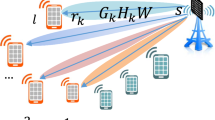Abstract
BLAST, a MIMO wireless communication systems can achieve very high spectral efficiency in rich multipath environment through exploiting the extra space dimension. A simplified version of BLAST known as V-BLAST has been proposed and implemented. In this paper we compare the performance of various V-BLAST algorithms through computer simulations. The results show that the nonlinear detection schemes with interference cancellation (IC) have much better performance than linear detection schemes and Minimum Mean Squared Error schemes (MMSE) have better performance than Zero Forcing (ZF) schemes. The efficient square-root algorithm with IC shows very attractive property that having low complexity while keeping the good performance compared with conventional IC scheme. In our simulation, little improvement is observed for the Pre-match filtering plus IC scheme.
The original version of this chapter was revised: The copyright line was incorrect. This has been corrected. The Erratum to this chapter is available at DOI: 10.1007/978-0-387-35618-1_37
Chapter PDF
Similar content being viewed by others
Reference
P.W. Wolniansky, G.J. Foschini, G.D. Golden and R.A. Valenzuela, “V-BLAST: an architecture for realizing very high data rates over the rich-scattering wireless channel”, in Proceeding of URSI International Symposium on Signals, Systems, and Electronics (ISSSE’98), pp. 295 –300, 1998.
G.J. Foschini and M.J. Gans, “On limits of wireless communications in a fading environment when using multiple antennas”, Wireless Personal Communications, vol. 6, no. 3, pp. 311–335, Mar. 1998.
G.J. Foschini, “Layered space-time architecture for wireless communication in a fading environment when using multi-element antennas”, Bell Labs Tech. J., pp.41–59, Autumn 1996.
G.G. Raleigh and J.M.Cioffi, “Spatio-temporal coding for wireless communication”, IEEE Trans. Commun., vol. 46, pp. 357–366, Mar. 1998.
G.D. Golden, G.J. Foschini, R. A. Valenzuela, and P.W. Wolniansky, “Detection algorithm and Initial Laboratory Results using the V-BLAST Space-Time Communication Architecture”, Electronic Letters, Vol. 35, No. 1, Jan. 7, 1999, pp. 14–15.
Li, X.; Huang, H.; Foschini, G.J.; Valenzuela, R.A., “Effects of iterative detection and decoding on the performance of BLAST’,Global Telecommunications Conference, 2000. GLOBECOM 00. IEEE, Volume: 2, 2000 Page(s): 1061–1066 vol. 2.
Won-Joon Choi; Negi, R.; Cioffi, J.M. “Combined ML and DFE decoding for the V-BLAST system”, in Proceeding of IEEE International Conference on Communications, Vol. 3, pp. 1243 –1248, 2000.
Wong Kwan Wai; Chi-Ying Tsui; Cheng, R.S. “A low complexity architecture of the V-BLAST system”,Wireless Communications and Networking Confemce, 2000. WCNC. 2000 IEEE, Volume: 1, 2000 Page(s): 310–314 vol.l.
Babak Hassibi “An efficient square-root algorithm for BLAST.
S. Sfar, N. Boubaker, R.D. Murch, and K.B. Letaief, “Performance of packetized layered space-time detection over wireless links”, ISCC’, 2001, pp 592–596, 2001.
Author information
Authors and Affiliations
Editor information
Editors and Affiliations
Rights and permissions
Copyright information
© 2003 IFIP International Federation for Information Processing
About this chapter
Cite this chapter
Zhu, H., Lei, Z., Chin, F. (2003). Performance Comparison of Multiple-Transmit Multiple-Receive V-BLAST algorithms. In: Omidyar, C.G. (eds) Mobile and Wireless Communications. IFIP — The International Federation for Information Processing, vol 106. Springer, Boston, MA. https://doi.org/10.1007/978-0-387-35618-1_2
Download citation
DOI: https://doi.org/10.1007/978-0-387-35618-1_2
Publisher Name: Springer, Boston, MA
Print ISBN: 978-1-4757-1033-5
Online ISBN: 978-0-387-35618-1
eBook Packages: Springer Book Archive




